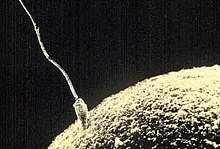


Oogamy is a form of anisogamy where the gametes differ in both size and form. In oogamy the large female gamete (also known as ovum) is immotile, while the small male gamete (also known as sperm) is mobile.[1] Oogamy is a common form of anisogamy, with almost all animals and land plants being oogamous.
Oogamy is found in most sexually reproducing species, including all vertebrates, land plants, and some algae. The ancestral state of sexual reproduction is believed to be isogamy, with oogamy evolving through anisogamy. Once oogamy evolves, males and females typically differ in various aspects. Internal fertilization may have originated from oogamy, although some studies suggest [2] that oogamy in certain species may have evolved before the transition from external to internal fertilization. In streptophytes, oogamy occurred before the split from green algae.
Oogamy is found in almost all animal species that reproduce sexually.[3][4] There are exceptions, such as the opiliones that have immobile sperm.[5]
Oogamy is found in all land plants,[6] and in some red algae, brown algae and green algae.[7] Oogamy is favored in land plants because only one gamete has to travel through harsh environments outside the plant.[8] Oogamy is also present in oomycetes.[9]
The term oogamy was first used in the year 1888.[10]
It is generally accepted that isogamy is the ancestral state[11] and that oogamy evolves from isogamy through anisogamy.[12][13][14] When oogamy has evolved, males and females typically differ in many aspects. Oogamy evolved before the transition from externaltointernal fertilization.[15][non-primary source needed][4]
Instreptophytes, oogamy occurred before the split from green algae.[16]
|
| |
|---|---|
| Types |
|
| Fossil record |
|
| Biology |
|
| Components |
|
| As food |
|
| In culture |
|
| |